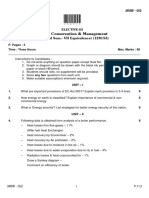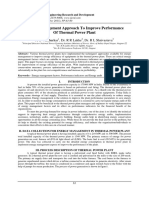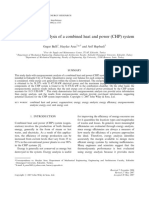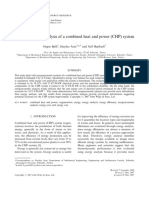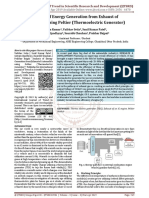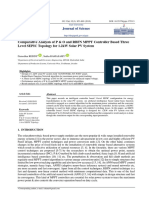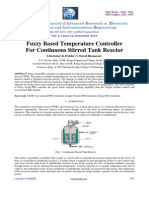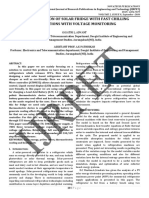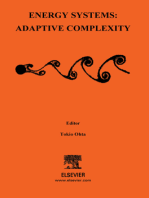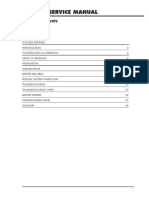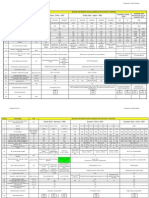Professional Documents
Culture Documents
A Review of Solar Water Heater Setup Energy Analysis Using Heat Exchanger
Copyright
Available Formats
Share this document
Did you find this document useful?
Is this content inappropriate?
Report this DocumentCopyright:
Available Formats
A Review of Solar Water Heater Setup Energy Analysis Using Heat Exchanger
Copyright:
Available Formats
Volume 5, Issue 7, July – 2020 International Journal of Innovative Science and Research Technology
ISSN No:-2456-2165
A Review of Solar Water Heater Setup Energy
Analysis Using Heat Exchanger
S. ARUNKUMAR 1, B. GURUPRASAD 2
1
PG SCHOLAR MECHANICAL ENGG .,
2
ASSISTANT PROFESSOR DEPARTMENT OF MECHANICAL ENGG.,
1, 2
ACGCET, KARAIKUD 630003, TAMILNADU, INDIA.
Abstract:- The main objective is to find out the Energy II. METHODOLOGY
analysis of the solar water heater. This work and
analysis to the study is to understand the amount of The energy storage material has selected from the
energy should be stored from the heat exchanger setup. literature paper work. The energy storage has been analysis
The large amount of energy has to be wasted and useless. from the system.
So that these large amount of waste heat energy can be
stored from the heat exchanger setup. It will help to Energy Analysis
reduce the large amount of heat energy can be stored
and to utilize the needed work. My review work is to Formulae for Energy Analysis
calculate the amount of energy can be wasted and how At the time of charging and discharging of the Thermal
much amount of energy can be stored from the energy energy storage, the input and output energies were
storage setup. calculated using the following equations.
Keywords:- Solar Water Heater, Heat Exchanger, Energy
Analysis.
I. INTRODUCTION
Energy analysis is the traditional method of assessing
the way energy is used in an operation involving the
physical or chemical processing of materials and the transfer 𝟎
and or conversion of energy. This usually entails performing Where,
energy balances, which are based on the FLT, and Ein = Heat absorbed by the material
evaluating energy efficiencies. This balance is employed to Eout = Heat gained by the Heat transfer fluid(HTF) from
determine and reduce waste energy emissions like heat the energy storage material
losses and sometimes to enhance waste and heat recovery. 𝑪𝒘= Specific heat of the HTF
𝑻𝒊𝒏 =Inlet temperature of the HTF
However, an energy balance provides no information 𝑻𝒐𝒖𝒕 =Outlet temperature of the HTF
on the degradation of energy or resources during a process
and does not quantify the usefulness or quality of the various
energy and material streams flowing through a system and
exiting as products and wastes.
The energy method of analysis overcomes the III. EXPERIMENTAL DESCRIPTION
limitations of the FLT. The concept of energy is based on
both the FLT and the SLT. Energy analysis clearly indicates The energy storage test kit was design and
the locations of energy degradation in a process and can manufacturing by myself. The test kit was tested
therefore lead to improved operation or technology. Energy at alagappa chettiar government college of
analysis can also quantify the quality of heat in a waste engineering and technology, karaikudi. The
stream. A main aim of energy analysis is to identify testing time between morning 10 am to evening
meaningful (energy) efficiencies and the causes and true 4pm onwards.
magnitudes of energy losses.
IJISRT20JUL157 www.ijisrt.com 275
Volume 5, Issue 7, July – 2020 International Journal of Innovative Science and Research Technology
ISSN No:-2456-2165
Fig.1:- Energy lab solar water heater connect to the energy storage setup
The test kit was connected to the solar water heater setup at ACGCET college Mechanical department,
Energy lab.
Fig. 2:- Energy storage setup filled with energy storage material(Zeolite)
Time Ein(KJ) Eout(KJ) Eloss(KJ) Efficiency (%)
10am 340 270 60 79
11am 325 265 60 81
12pm 300 275 25 91
1pm 285 255 30 89
2Pm 280 200 80 71
3Pm 270 185 85 68
4pm 255 140 115 54
Average efficiency 76%
Table.1:- Energy analysis
IJISRT20JUL157 www.ijisrt.com 276
Volume 5, Issue 7, July – 2020 International Journal of Innovative Science and Research Technology
ISSN No:-2456-2165
IV. RESULT AND DISCUSSION
The experimental work was carried out in two processes, which is mentioned below.
Energy absorption
Energy desorption
TIME vs Ein(KJ)
300
250
200
Ein(KJ)
150
100 Eout(KJ)
50
0
1pm 2Pm 3Pm 4pm
10am 11am 12pm
TIME
Fig.3:- Energy Absorption Graph
TIME vs Eout(KJ)
300
250
200
Eout(KJ)
150
100 Eout(KJ)
50
0
1pm 2Pm 3Pm 4pm
10am 11am 12pm
TIME
Fig.4:- Energy Desorption Graph
IJISRT20JUL157 www.ijisrt.com 277
Volume 5, Issue 7, July – 2020 International Journal of Innovative Science and Research Technology
ISSN No:-2456-2165
TIME VS Ein & Eout
400
350
300
Ein & Eout
250
200 Time
150 Ein(KJ)
100 Eout(KJ)
50
0
1 2 3 4 5 6 7 8
Time
Fig.5:- Time vs Energy in & Energy out Graph
V. CONCLUSION
REFERENCES
From the present research work the following
concluding remarks are made: [1]. Vishal G. Shelke1 , Chinmay V. Patil2 , Kishor R.
The experimental setup of shell and tube energy storage Sontakke3 “Solar Water Heating Systems: A Review”
device is designed and fabricated, in order to utilize the ,ISSN (Online): 2347-3878, Impact Factor (2014):
Energy storage material for solar energy storage and 3.05
recovery. [2]. M. Mani Bharathi, Shams Hari Prasad Mohan,
The experimental setup performance was examined by Santhosh Sivan.M,
using solar water collector. Karthikeyan.S “Design and Fabrication of Shell and
Tube Heat Exchanger”, ISSN: 2455-7137 Volume –
The energy analysis was done and efficiency of the
02, Issue – 04, April – 2017, PP – 35-39
thermal energy storage system was calculated.
[3]. Sandeep Kumar Dehariya*1 Dr. A. R. Jaurker2 “
Efficiency Evaluation of Heat Exchanger Based
Nomenclature
Domestic Solar Water Heater - A Review”, ISSN:
Amod area of the solar module (m2) 2277-9655
[4]. Shoma Fujiia,⁎, Naoyuki Horiea, Ko Nakaibayashia,
Cp specific heat of air (kJ/kg K) Yuichiro Kanematsub, Yasunori Kikuchib,
Takao Nakagakia “Design of zeolite boiler in
G solar radiation (W/m2)
thermochemical energy storage and transport system
ṁ Mass flow rate of water(kg/s) utilizing unused heat from sugar mill”, applied energy
238(2019) 561-571
Qu useful heat (W) [5]. Christoph Lehmanna,b, Steffen Beckertc, Thomas
Nonnenc, Jens Möllmerd, Roger
Ti inlet temperature(0C) Gläserc, Olaf Kolditza,b, Thomas Nagela,e,* Energy
To outlet temperature(0C) Procedia 105 ( 2017 ) 4334 – 4339
[6]. 6.Yaxue Lin, Review on thermal conductivity
v velocity of water (m/s) enhancement, thermal properties and Applications of
phase change materials in thermal energy storage
Greek letters (2018)
[7]. Energy around the world by J C McVeigh, Brighton
ρ density (kg/m3) polytechnic, UK
ηth thermal efficiency (%)
IJISRT20JUL157 www.ijisrt.com 278
You might also like
- A Pilot Power Plant Based On Concentrating Solar and Energy Storage Technologies For Improving Electricity DispatchDocument8 pagesA Pilot Power Plant Based On Concentrating Solar and Energy Storage Technologies For Improving Electricity Dispatchayupermata2106No ratings yet
- Home Work EE II SS 2020Document4 pagesHome Work EE II SS 2020Muhammad WaseemNo ratings yet
- Contoh JurnalDocument9 pagesContoh JurnalMuhammad DaffaNo ratings yet
- Exergoeconomic Analysis of A Combined Heat and Power (CHP) SystemDocument18 pagesExergoeconomic Analysis of A Combined Heat and Power (CHP) Systemmehdi siyahiNo ratings yet
- IJERT Energy and Exergy Analysis of CoalDocument3 pagesIJERT Energy and Exergy Analysis of Coaljohn patrick camoNo ratings yet
- Thermal Power Plant Exergy AnalysisDocument9 pagesThermal Power Plant Exergy AnalysisNGUYEN QUANGNo ratings yet
- 26 Jnae10124 PDFDocument11 pages26 Jnae10124 PDFKevin DarmawanNo ratings yet
- Energy and Exergy Analysis of Dry-Steam Geothermal Power Plant: Case Study in Kamojang Geothermal Power Plant Unit 2Document5 pagesEnergy and Exergy Analysis of Dry-Steam Geothermal Power Plant: Case Study in Kamojang Geothermal Power Plant Unit 2Miranda Roulina TampubolonNo ratings yet
- Energetic Analyses of The Combined Heat and Power (CHP) SystemDocument26 pagesEnergetic Analyses of The Combined Heat and Power (CHP) Systemjonathan arboledaNo ratings yet
- Power Generation From Exhaust Gas & Engine Heat Using Teg.: ST - Vincent Pallotti College of Engineering and TechnologyDocument3 pagesPower Generation From Exhaust Gas & Engine Heat Using Teg.: ST - Vincent Pallotti College of Engineering and TechnologyMamta SarkarNo ratings yet
- Case Studies in Thermal EngineeringDocument10 pagesCase Studies in Thermal Engineeringedo istimawanNo ratings yet
- Andono Kusuma Jati - 21030118110001 - Tugasakhir PinchDocument27 pagesAndono Kusuma Jati - 21030118110001 - Tugasakhir Pinchandono kusuma jatiNo ratings yet
- Electrical Demand Forecasting TechniquesDocument36 pagesElectrical Demand Forecasting TechniquesDrGopikrishna PasamNo ratings yet
- Thermal Runaway Features of Large Format Prismatic Lithium IonDocument8 pagesThermal Runaway Features of Large Format Prismatic Lithium IonGabriel AraujoNo ratings yet
- EnergyConservation Management March2018 B E Withcredits RegularCGPAPatternBE 8F8DBB41Document4 pagesEnergyConservation Management March2018 B E Withcredits RegularCGPAPatternBE 8F8DBB41sumitNo ratings yet
- Effect of The Variable Air Volume On Energy ConsumDocument8 pagesEffect of The Variable Air Volume On Energy ConsumandreNo ratings yet
- Summer Internship at "G.S.E.C.L. Thermal Power Station Sikka''Document25 pagesSummer Internship at "G.S.E.C.L. Thermal Power Station Sikka''ARJUN SOMAIYANo ratings yet
- Energy Conversion and Management: Usman Muhammad, Muhammad Imran, Dong Hyun Lee, Byung Sik ParkDocument12 pagesEnergy Conversion and Management: Usman Muhammad, Muhammad Imran, Dong Hyun Lee, Byung Sik Parkmadalina.andreea.vasileNo ratings yet
- Enms in Power PlantDocument18 pagesEnms in Power PlantNasional GotongroyongNo ratings yet
- History of Thermal Power PlantsDocument9 pagesHistory of Thermal Power PlantsAnonymous gr5Pr9AVNo ratings yet
- Exergoeconomic Analysis of A Combined Heat and Power (CHP) SystemDocument17 pagesExergoeconomic Analysis of A Combined Heat and Power (CHP) SystemRakibHassanAkashNo ratings yet
- Exergoeconomic Analysis of A Combined Heat and Power (CHP) SystemDocument17 pagesExergoeconomic Analysis of A Combined Heat and Power (CHP) Systemjhugo_mirandaNo ratings yet
- Load Shifting Assessment of Residential Heat Pump System in JapanDocument8 pagesLoad Shifting Assessment of Residential Heat Pump System in JapanIEREKPRESSNo ratings yet
- 2007 Inkson, CO-GENERATION THERMODYNAMICS REVISITEDDocument11 pages2007 Inkson, CO-GENERATION THERMODYNAMICS REVISITEDAbraham.CastilloNo ratings yet
- Thermal Management of A Lithium Ion Battery Module Using A Thermoelectric Cooler With Stirling Engine Heat Pump 1Document55 pagesThermal Management of A Lithium Ion Battery Module Using A Thermoelectric Cooler With Stirling Engine Heat Pump 1Joshua Roberto GrutaNo ratings yet
- Experimental Research of Thermal Electric Power GeDocument8 pagesExperimental Research of Thermal Electric Power GeDaniel TangkauNo ratings yet
- Energy: H. Rosyid, R. Koestoer, N. Putra, Nasruddin, A.A. Mohamad, YanuarDocument9 pagesEnergy: H. Rosyid, R. Koestoer, N. Putra, Nasruddin, A.A. Mohamad, YanuarIvanNo ratings yet
- ANALYSIS OF FUEL CONSUMPTION AT STEAM POWER PLANTSDocument4 pagesANALYSIS OF FUEL CONSUMPTION AT STEAM POWER PLANTSryan hardiantoNo ratings yet
- Ocean ThermalDocument10 pagesOcean ThermalTienRienNo ratings yet
- Analysis of Energy Generation From Exhaust of Automobile Using Peltier Thermoelectric GeneratorDocument3 pagesAnalysis of Energy Generation From Exhaust of Automobile Using Peltier Thermoelectric GeneratorEditor IJTSRDNo ratings yet
- Thermocouple Experiment: January 1, 2011Document12 pagesThermocouple Experiment: January 1, 2011Lidya VelesiaNo ratings yet
- Exergetic Analysis of A New Design PhotovoltaicDocument5 pagesExergetic Analysis of A New Design PhotovoltaicİSMAİL ÇİYLEZNo ratings yet
- JurnalDocument5 pagesJurnaldio prabowoNo ratings yet
- Appropriate Methods For Evaluating The Efficiency and Capacitive Behavior of Different Types of SupercapacitorsDocument5 pagesAppropriate Methods For Evaluating The Efficiency and Capacitive Behavior of Different Types of Supercapacitors林祐任No ratings yet
- Design and Development of Heat ExchangerDocument6 pagesDesign and Development of Heat ExchangerInternational Journal of Innovative Science and Research TechnologyNo ratings yet
- Experiment Study of Water Based Photovoltaic-Thermal (PV/T) CollectorDocument8 pagesExperiment Study of Water Based Photovoltaic-Thermal (PV/T) CollectorYulia FithryNo ratings yet
- 0B ExperimentalDocument10 pages0B ExperimentalMo'men NabilNo ratings yet
- Thermodynamic Modeling and Optimization of A Coal Fired Thermal Power Plant Using Cycle Tempo, Taguchi and ANOVADocument10 pagesThermodynamic Modeling and Optimization of A Coal Fired Thermal Power Plant Using Cycle Tempo, Taguchi and ANOVARituraj SinghNo ratings yet
- SUMMER INTERNSHIP REPORTDocument19 pagesSUMMER INTERNSHIP REPORTmalikavita731No ratings yet
- Performance of Photovoltaic System's Maximum Power Point TrackingDocument8 pagesPerformance of Photovoltaic System's Maximum Power Point TrackingramezhosnyNo ratings yet
- 2.-Galicia - J. Chem. Eng. Data 2013, 58, 1255 1264 - 5Document10 pages2.-Galicia - J. Chem. Eng. Data 2013, 58, 1255 1264 - 5Moltimer Folchart CrawNo ratings yet
- 10 35378-Gujs 375313-792544Document17 pages10 35378-Gujs 375313-792544azeygpchNo ratings yet
- Energy, Exergyand Energy Audit Analysis of Vijayawada Thermal Power StationDocument8 pagesEnergy, Exergyand Energy Audit Analysis of Vijayawada Thermal Power Stationjhugo_mirandaNo ratings yet
- Renewable Energy: Naveen Kumar, G. Vishwanath, Anurag GuptaDocument6 pagesRenewable Energy: Naveen Kumar, G. Vishwanath, Anurag GuptaManikandan SundararajNo ratings yet
- Equations For SF and Primary Energy SavingsDocument9 pagesEquations For SF and Primary Energy Savingsmuhammad.arslanNo ratings yet
- Exergy Analysis Back Pressure Turbine Rana Mehtadd IJMERDocument8 pagesExergy Analysis Back Pressure Turbine Rana Mehtadd IJMERSky 6794No ratings yet
- Exergy Analysis of Gas Turbine Power Plant 20 MW in Pekanbaru-IndonesiaDocument7 pagesExergy Analysis of Gas Turbine Power Plant 20 MW in Pekanbaru-IndonesiaEfransyahNo ratings yet
- Art 3Document7 pagesArt 3Adel KlkNo ratings yet
- Evaluation of Nominal Operating Cell Temperature (NOCT)Document15 pagesEvaluation of Nominal Operating Cell Temperature (NOCT)Efstathios MaliakisNo ratings yet
- Performance Evaluation For Indirect Evaporative Cooling On Cellular SitesDocument52 pagesPerformance Evaluation For Indirect Evaporative Cooling On Cellular SitesAndres Felipe SánchezNo ratings yet
- Fuzzy Based Temperature Controller For Continuous Stirred Tank ReactorDocument8 pagesFuzzy Based Temperature Controller For Continuous Stirred Tank Reactorjuankobe3No ratings yet
- Solar RefrigeratorDocument5 pagesSolar RefrigeratorJournalNX - a Multidisciplinary Peer Reviewed JournalNo ratings yet
- ROOM NO. 001, 103, 201, 202, 203, 204, 205, & 206.: Faculty CabinsDocument3 pagesROOM NO. 001, 103, 201, 202, 203, 204, 205, & 206.: Faculty CabinsrohitNo ratings yet
- Exergy analysis of a thermal power plantDocument7 pagesExergy analysis of a thermal power plantDamianus tri handokoNo ratings yet
- A Polygeneration Process Concept for Hybrid Solar and Biomass Power Plant: Simulation, Modelling, and OptimizationFrom EverandA Polygeneration Process Concept for Hybrid Solar and Biomass Power Plant: Simulation, Modelling, and OptimizationNo ratings yet
- Thermodynamic Design Data for Heat Pump Systems: A Comprehensive Data Base and Design ManualFrom EverandThermodynamic Design Data for Heat Pump Systems: A Comprehensive Data Base and Design ManualNo ratings yet
- Quick Review Outline - Masschusetts Testing for Educator Licensure (MTEL) Tech and Eng ExamFrom EverandQuick Review Outline - Masschusetts Testing for Educator Licensure (MTEL) Tech and Eng ExamNo ratings yet
- The Making of Self-Disposing Contactless Motion-Activated Trash Bin Using Ultrasonic SensorsDocument7 pagesThe Making of Self-Disposing Contactless Motion-Activated Trash Bin Using Ultrasonic SensorsInternational Journal of Innovative Science and Research TechnologyNo ratings yet
- Exploring the Clinical Characteristics, Chromosomal Analysis, and Emotional and Social Considerations in Parents of Children with Down SyndromeDocument8 pagesExploring the Clinical Characteristics, Chromosomal Analysis, and Emotional and Social Considerations in Parents of Children with Down SyndromeInternational Journal of Innovative Science and Research TechnologyNo ratings yet
- Intelligent Engines: Revolutionizing Manufacturing and Supply Chains with AIDocument14 pagesIntelligent Engines: Revolutionizing Manufacturing and Supply Chains with AIInternational Journal of Innovative Science and Research TechnologyNo ratings yet
- Advancing Opthalmic Diagnostics: U-Net for Retinal Blood Vessel SegmentationDocument8 pagesAdvancing Opthalmic Diagnostics: U-Net for Retinal Blood Vessel SegmentationInternational Journal of Innovative Science and Research TechnologyNo ratings yet
- Handling Disruptive Behaviors of Students in San Jose National High SchoolDocument5 pagesHandling Disruptive Behaviors of Students in San Jose National High SchoolInternational Journal of Innovative Science and Research TechnologyNo ratings yet
- Natural Peel-Off Mask Formulation and EvaluationDocument6 pagesNatural Peel-Off Mask Formulation and EvaluationInternational Journal of Innovative Science and Research TechnologyNo ratings yet
- Beyond Shelters: A Gendered Approach to Disaster Preparedness and Resilience in Urban CentersDocument6 pagesBeyond Shelters: A Gendered Approach to Disaster Preparedness and Resilience in Urban CentersInternational Journal of Innovative Science and Research TechnologyNo ratings yet
- Placement Application for Department of Commerce with Computer Applications (Navigator)Document7 pagesPlacement Application for Department of Commerce with Computer Applications (Navigator)International Journal of Innovative Science and Research TechnologyNo ratings yet
- Fruit of the Pomegranate (Punica granatum) Plant: Nutrients, Phytochemical Composition and Antioxidant Activity of Fresh and Dried FruitsDocument6 pagesFruit of the Pomegranate (Punica granatum) Plant: Nutrients, Phytochemical Composition and Antioxidant Activity of Fresh and Dried FruitsInternational Journal of Innovative Science and Research TechnologyNo ratings yet
- A Knowledg Graph Model for e-GovernmentDocument5 pagesA Knowledg Graph Model for e-GovernmentInternational Journal of Innovative Science and Research TechnologyNo ratings yet
- REDLINE– An Application on Blood ManagementDocument5 pagesREDLINE– An Application on Blood ManagementInternational Journal of Innovative Science and Research TechnologyNo ratings yet
- Pdf to Voice by Using Deep LearningDocument5 pagesPdf to Voice by Using Deep LearningInternational Journal of Innovative Science and Research TechnologyNo ratings yet
- A Curious Case of QuadriplegiaDocument4 pagesA Curious Case of QuadriplegiaInternational Journal of Innovative Science and Research TechnologyNo ratings yet
- Safety, Analgesic, and Anti-Inflammatory Effects of Aqueous and Methanolic Leaf Extracts of Hypericum revolutum subsp. kenienseDocument11 pagesSafety, Analgesic, and Anti-Inflammatory Effects of Aqueous and Methanolic Leaf Extracts of Hypericum revolutum subsp. kenienseInternational Journal of Innovative Science and Research TechnologyNo ratings yet
- Analysis of Financial Ratios that Relate to Market Value of Listed Companies that have Announced the Results of their Sustainable Stock Assessment, SET ESG Ratings 2023Document10 pagesAnalysis of Financial Ratios that Relate to Market Value of Listed Companies that have Announced the Results of their Sustainable Stock Assessment, SET ESG Ratings 2023International Journal of Innovative Science and Research TechnologyNo ratings yet
- Food habits and food inflation in the US and India; An experience in Covid-19 pandemicDocument3 pagesFood habits and food inflation in the US and India; An experience in Covid-19 pandemicInternational Journal of Innovative Science and Research TechnologyNo ratings yet
- Adoption of International Public Sector Accounting Standards and Quality of Financial Reporting in National Government Agricultural Sector Entities, KenyaDocument12 pagesAdoption of International Public Sector Accounting Standards and Quality of Financial Reporting in National Government Agricultural Sector Entities, KenyaInternational Journal of Innovative Science and Research TechnologyNo ratings yet
- Improvement Functional Capacity In Adult After Percutaneous ASD ClosureDocument7 pagesImprovement Functional Capacity In Adult After Percutaneous ASD ClosureInternational Journal of Innovative Science and Research TechnologyNo ratings yet
- Design and Implementation of Homemade Food Delivery Mobile Application Using Flutter-FlowDocument7 pagesDesign and Implementation of Homemade Food Delivery Mobile Application Using Flutter-FlowInternational Journal of Innovative Science and Research TechnologyNo ratings yet
- Machine Learning and Big Data Analytics for Precision Cardiac RiskStratification and Heart DiseasesDocument6 pagesMachine Learning and Big Data Analytics for Precision Cardiac RiskStratification and Heart DiseasesInternational Journal of Innovative Science and Research TechnologyNo ratings yet
- Optimization of Process Parameters for Turning Operation on D3 Die SteelDocument4 pagesOptimization of Process Parameters for Turning Operation on D3 Die SteelInternational Journal of Innovative Science and Research TechnologyNo ratings yet
- Design and Development of Controller for Electric VehicleDocument4 pagesDesign and Development of Controller for Electric VehicleInternational Journal of Innovative Science and Research TechnologyNo ratings yet
- The Students’ Assessment of Family Influences on their Academic MotivationDocument8 pagesThe Students’ Assessment of Family Influences on their Academic MotivationInternational Journal of Innovative Science and Research Technology100% (1)
- Forensic Evidence Management Using Blockchain TechnologyDocument6 pagesForensic Evidence Management Using Blockchain TechnologyInternational Journal of Innovative Science and Research TechnologyNo ratings yet
- Scrolls, Likes, and Filters: The New Age Factor Causing Body Image IssuesDocument6 pagesScrolls, Likes, and Filters: The New Age Factor Causing Body Image IssuesInternational Journal of Innovative Science and Research TechnologyNo ratings yet
- Severe Residual Pulmonary Stenosis after Surgical Repair of Tetralogy of Fallot: What’s Our Next Strategy?Document11 pagesSevere Residual Pulmonary Stenosis after Surgical Repair of Tetralogy of Fallot: What’s Our Next Strategy?International Journal of Innovative Science and Research TechnologyNo ratings yet
- Late Presentation of Pulmonary Hypertension Crisis Concurrent with Atrial Arrhythmia after Atrial Septal Defect Device ClosureDocument12 pagesLate Presentation of Pulmonary Hypertension Crisis Concurrent with Atrial Arrhythmia after Atrial Septal Defect Device ClosureInternational Journal of Innovative Science and Research TechnologyNo ratings yet
- Enhancing Biometric Attendance Systems for Educational InstitutionsDocument7 pagesEnhancing Biometric Attendance Systems for Educational InstitutionsInternational Journal of Innovative Science and Research TechnologyNo ratings yet
- Blockchain-Enabled Security Solutions for Medical Device Integrity and Provenance in Cloud EnvironmentsDocument13 pagesBlockchain-Enabled Security Solutions for Medical Device Integrity and Provenance in Cloud EnvironmentsInternational Journal of Innovative Science and Research TechnologyNo ratings yet
- The Experiences of Non-PE Teachers in Teaching First Aid and Emergency Response: A Phenomenological StudyDocument89 pagesThe Experiences of Non-PE Teachers in Teaching First Aid and Emergency Response: A Phenomenological StudyInternational Journal of Innovative Science and Research TechnologyNo ratings yet
- APPENDIX B Filler Metal Comparison Chart ABS-AWSDocument3 pagesAPPENDIX B Filler Metal Comparison Chart ABS-AWSplkv100% (1)
- Palm Oil Fiber ConcreteDocument9 pagesPalm Oil Fiber ConcreteGladys Eras ValladolidNo ratings yet
- CurrentDocument49 pagesCurrentTouati SaidNo ratings yet
- STM 124 Electronic Configuration and Quantum NumbersDocument18 pagesSTM 124 Electronic Configuration and Quantum NumbersIvana BalanoNo ratings yet
- 04 - Metode ElektrogravimetriDocument19 pages04 - Metode ElektrogravimetriNurul Aulia HusainNo ratings yet
- CWP Cert PDFDocument4 pagesCWP Cert PDFmurtazagulzar3No ratings yet
- Formulation Development and Evaluation of Sustained Release Tablets of AceclofenacDocument128 pagesFormulation Development and Evaluation of Sustained Release Tablets of Aceclofenacraju narayana padala0% (1)
- Estimacion Del AOFDocument12 pagesEstimacion Del AOFPedro Antonio Lea Plaza RicoNo ratings yet
- Redox Reactions (Theory) EditedDocument21 pagesRedox Reactions (Theory) EditedProfSumit LuthraNo ratings yet
- Agru Catalogue PDFDocument505 pagesAgru Catalogue PDFAhmed HussienNo ratings yet
- Hawker Battery Service ManualDocument59 pagesHawker Battery Service ManualBill Waters100% (1)
- Physico-chemical Water Treatment Processes AssignmentDocument6 pagesPhysico-chemical Water Treatment Processes AssignmentAbir HasanNo ratings yet
- Overall Heat Transfer Coefficient and Pipe Length CalculationDocument2 pagesOverall Heat Transfer Coefficient and Pipe Length CalculationCaleb FalcoteloNo ratings yet
- Morbido Af-99100 v12 Msds enDocument14 pagesMorbido Af-99100 v12 Msds enjanNo ratings yet
- T04: Mass Balance in Non Reacting System (Introduction Tu Multi Unit) A. Sugar Factory Activity (6 Min)Document2 pagesT04: Mass Balance in Non Reacting System (Introduction Tu Multi Unit) A. Sugar Factory Activity (6 Min)Dewi Mawaddatus SholekhahNo ratings yet
- Torqueo Pikotek PDFDocument4 pagesTorqueo Pikotek PDFjast111100% (1)
- HöglundDocument70 pagesHöglundIndri AuraliaNo ratings yet
- PV Module IonDocument4 pagesPV Module IonrmalewarNo ratings yet
- T06002.006 Viva E System Onsite Training Workbook Eff Date 09-13-21Document66 pagesT06002.006 Viva E System Onsite Training Workbook Eff Date 09-13-21Zitouni LamineNo ratings yet
- s4 Chemistry Paper 1 Set 1 Marking GuideDocument11 pagess4 Chemistry Paper 1 Set 1 Marking GuideNamuli MercyNo ratings yet
- Allelopathic Potential of Tagetes Minuta Terpenes by A ChemicalDocument9 pagesAllelopathic Potential of Tagetes Minuta Terpenes by A ChemicalbiologiaufbaNo ratings yet
- Chapter 3 2Document41 pagesChapter 3 2jerrica thomasNo ratings yet
- Stoichiometry Questions & AnswersDocument2 pagesStoichiometry Questions & Answersnosirat aladeNo ratings yet
- Microporous and Mesoporous Materials: Sean M.W. Wilson, Vida A. Gabriel, F.Handan TezelDocument11 pagesMicroporous and Mesoporous Materials: Sean M.W. Wilson, Vida A. Gabriel, F.Handan TezelEcNo ratings yet
- VacuumDocument7 pagesVacuumMassimilianø Erricø100% (1)
- Distillation Column PipingDocument57 pagesDistillation Column PipingKaran Singh92% (13)
- Epoxy resin free flow grout for heavy duty applicationsDocument4 pagesEpoxy resin free flow grout for heavy duty applicationsFeri Oktara IrawanNo ratings yet
- Deformation and Fracture Mechanics of Engineering MaterialsDocument44 pagesDeformation and Fracture Mechanics of Engineering MaterialsSyed Muhammad AliNo ratings yet
- Astm A500Document2 pagesAstm A500Liquor Liam0% (1)
- Injection of Flux Into The BlastDocument8 pagesInjection of Flux Into The BlastWesley CostaNo ratings yet














